Precision engineering with helical gears requires careful consideration during both the design and manufacturing stages to ensure optimal performance and reliability. Here are key considerations for precision engineering with helical gears:

1. Gear Design:
- Accurate Tooth Profile: Design the helical gear with precise tooth profiles to ensure smooth tooth engagement and minimize noise and vibrations during operation. Use specialized gear design software and adhere to recognized standards for tooth geometry.
- Proper Helix Angle: Determine the appropriate helix angle based on the application requirements to achieve the desired load-carrying capacity and efficiency. The helix angle affects gear meshing, load distribution, and axial thrust.
- Tooth Contact Analysis: Conduct tooth contact analysis to ensure that the contact pattern is evenly distributed along the tooth flank for uniform load sharing and reduced wear.
2. Material Selection:
- High-Quality Materials: Choose materials with excellent strength, hardness, and wear resistance to ensure the gears can handle the expected loads and operating conditions. Consider factors like tooth loading, speed, and environmental conditions when selecting materials.
3. Manufacturing Techniques:
- CNC Machining: Utilize Computer Numerical Control (CNC) machining for precise and repeatable gear manufacturing. CNC machining ensures accurate tooth profiles and minimizes manufacturing errors.
- Gear Hobbing and Grinding: For high-volume production, use gear hobbing and grinding processes to achieve precise gear tooth profiles and superior surface finishes.
- Heat Treatment: Implement appropriate heat treatment processes to achieve the desired material properties, such as hardness and durability, ensuring optimal gear performance.
4. Gear Tooth Alignment:
- Gear Alignment: Ensure accurate gear tooth alignment during assembly to avoid misalignment-induced losses and premature wear. Proper alignment guarantees optimal gear meshing and performance.
5. Lubrication and Cooling:
- Effective Lubrication: Develop a lubrication strategy that ensures adequate lubrication between gear teeth to minimize friction, wear, and heat generation. Proper lubrication is essential for optimizing gear performance and lifespan.
- Cooling System: Incorporate a cooling system to dissipate heat generated during gear operation. Efficient cooling helps maintain the gear’s performance and prevents overheating-related failures.
6. Quality Control and Inspection:
- Rigorous Inspection: Implement quality control measures during manufacturing and perform rigorous inspections to verify gear dimensions, tooth profiles, and surface finishes. Inspections should adhere to relevant industry standards to ensure precision and reliability.
7. Noise Reduction:
- Microgeometry Modifications: Implement microgeometry modifications, such as tooth crowning, to optimize the gear contact pattern and reduce noise.
- Surface Finishing: Use advanced surface finishing techniques to achieve smoother gear surfaces, minimizing noise during meshing.
8. Maintenance and Monitoring:
- Regular Maintenance: Establish a maintenance schedule to monitor gear wear and perform necessary maintenance activities to ensure long-term precision and reliability.
- Condition Monitoring: Implement condition monitoring systems to assess gear health and detect potential issues early on.
In conclusion, precision engineering with helical gears involves meticulous design, careful material selection, advanced manufacturing techniques, and thorough quality control. By considering these key factors, engineers can achieve optimal gear performance, reduce noise, enhance gear durability, and ensure the successful integration of helical gears in various precision engineering applications.
